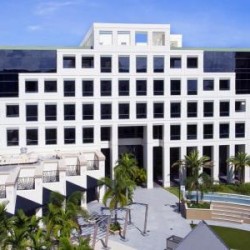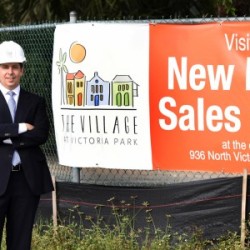The Year Ahead: A Glimpse At The Economic Outlook For South Florida
January 13th, 2015
The resurgent South Florida economy has the recession and real estate collapse of the late 2000s in its rear-view mirror. Led by rapid growth in construction jobs, South Florida is on track to further rebuild its employment base in 2015, expert observers say.
“We should do well in 2015,” said J. Antonio Villamil, founder and principal of the Washington Economics Group in Coral Gables. “We have a good business climate, low interest rates and low oil prices, so we’re coming into the new calendar year with a bang. … Construction, retail and anything to do with the visitor industry should do well.”
Villamil said employment in South Florida is growing across multiple industries: “It’s more diverse than just a boom in one sector. … South Florida is finishing the year [2014] with all the cylinders running at a high rate.”
High-rise construction is hot again, raising questions about its sustainability.
“You have to worry about it getting too robust, too frothy. You know, Florida has a history of that, boom-bust, and I think that’s one thing we’ve got to watch,” said David “Dave” Seleski, president and chief executive officer of Fort Lauderdale-based Stonegate Bank.
“You see the prices that condos are selling for, you see multifamily apartments popping up everywhere. You have got to wonder: At what point is it going to get overbuilt?”
But if history is a good guide, concern about another real estate meltdown in South Florida may be premature.
Mark Vitner, a senior economist of Wells Fargo Bank, said South Florida real estate slumps and economic recessions rarely coincide as they did in the late 2000s. He said it previously had happened in the early 1990s and the mid-1970s.
“The good news is that the real estate cycle tends to be twice as long as the business cycle, so real estate busts do not come along as often as recessions,” Vitner said.
“There’s no way to completely escape booms and busts in the real estate market,” but future busts may do less damage than past ones, he said.
“The Miami economy has broadened and deepened to a point where it … should be more durable than it has been in the past,” Vitner said.
Here are glimpses of the outlook in five key sectors of the South Florida economy:
CONSTRUCTION
Co-worker reunions have become a routine at Coastal Construction Group, which gradually has hired back some of the employees it laid off amid a breakdown in building activity from 2007 to 2010.
After downsizing its staff to survive the downturn, Miami-based Coastal resumed hiring — and rehiring — in 2011. “We have 54 people who we’ve talked to about coming back and 53 have rejoined us over the past three years,” said Tom C. Murphy, executive vice president of Coastal Construction Group.
Coastal now has more than 400 employees, up from its pre-slump head count of 350 in 2007, to handle its expanding business. The company expects revenue to grow from $850 million in 2014 to $900 million in 2015. Among its biggest current projects are the Porsche Design Tower, a luxury high-rise condominium building in Sunny Isles Beach, and SkyRise, a 1,000-foot observation tower in downtown Miami.
“We continue to see growth in the high rise residential,” Murphy said, and the market for residential estates with construction costs of $15 million to $50 million “is booming.”
The fortunes of other builders have improved, too. Over the past 10 years, average annual employment in South Florida’s construction sector bottomed at 85,100 in 2011 after peaking at 164,000 in 2006. The preliminary estimate of construction employment in November was 105,700 — still about 20 percent below the 125,000 level 10 years ago.
The temporarily muted construction industry is making big noises again: Employment is growing faster in construction than in any other sector of the economy. The number of construction jobs in Miami-Dade, Broward and Palm Beach counties grew by 8.9 percent from November 2013 to November 2014 while total employment in the area grew 3.4 percent. University of Central Florida economist Sean Snaith forecast that South Florida’s job base in construction will grow 11.6 percent in 2015.
Vitner said he expected even faster growth in construction employment, “given all the highly visible construction activity we see in South Florida. One possible explanation for that is, single-family home building has not come back at all. … The upper end of the condo market has been exceptionally strong, though it’s mostly an international phenomenon.”
High-rise residential development, dormant during the one-two punch of economic recession and the real estate collapse in the late 2000s, is surging again. But this segment of the construction industry may be less susceptible to a repeat of the last boom- and-bust cycle.
“I really think things are different this time,” said Gil Dezer, developer of the $500 million Porsche Design Tower, featuring elevators that will take residents and their cars to condo units with adjacent parking spaces.
South Florida condo purchases have been “sustained this time around,” Dezer said, crediting bigger deposits and down payments by buyers. “There’s a lot of cash from the buyers. There’s a lot less leverage than before when there were 80 percent and 90 percent mortgages.”
Compared to the mid-2000s, developers and lenders are less inclined to go forward with condo projects without ample presales, said economist J. Antonio Villamil, who also serves on the board of directors of Mercantil Commercebank, a Coral Gables-based U.S. bank with a Venezuelan parent company, Mercantil Servicios Financieros.
“Things are different than in the ‘bubble’ period,” Villamil said. “There’s more equity from the buyers being put in, and tougher credit standards.” Villamil also said that “in the prior cycles, we haven’t had the amount of foreign investment we’re having now.”
Banks are “lending but for viable projects,” he said. “I think developers, too, are more conscious of the fact that they may have to pull a permit to build a building. If presales are not strong, they may pull it off and wait awhile.”
TRADE
As the U.S. economy extends its recovery from the 2007-2009 recession, economic growth in many Latin American countries has declined along with the price of oil, copper and other commodities that the region exports.
“The only sector that hasn’t performed very well is international trade. That’s been down on a year-over-year basis in 2014 and 2013,” Miami-Dade County chief economist Robert Cruz said. “That’s a soft spot and, of course, much of that has to do with the economies of Latin America.”
Investors paid a price in 2014 for putting money in emerging foreign markets, “which have been a grave disappointment,” said Coral Gables-based financial advisor Cathy Pareto. Although she advises clients to spread investment risks over both domestic and foreign markets, 2014 was “a year when diversification, unfortunately, was a four-letter word.”
Among other signs of difficult times abroad, international passenger traffic at Miami International Airport decreased 1.58 percent through the first 10 months of 2014, compared to the same period in 2013, while international cargo tonnage increased just 0.71 percent.
“International trade has not been a leading sector of growth because Latin America has been slower. Lower commodity prices play a role in that,” Villamil said. . “Brazil is sluggish. It’ll do better in 2015, but technically it’s in recession,” he said. While the economic outlook for Central America and the Dominican Republic is generally positive, such countries as Argentina, Chile, Colombia, Ecuador, Mexico and Peru are experiencing economic slowdowns that will persist in 2015, and “the slower growth certainly is impacting our exports to them.”
Other parts of the world are in economic duress, too. “The eurozone is sluggish; it’s close to recession,” Villamil said. “Japan is already in a recession, so that’s a negative. China has slowed.”
But the Miami area has benefited in some ways from problems abroad. For example, as a result of economic stress in oil-dependent Venezuela, “we see more people coming here from Venezuela. That may be a positive for the real estate market and [bank] deposits here,” Villamil said.
A popular destination for international capital flows, South Florida “continues to be in that unique position where we benefit from the good and the bad [abroad],” said Francisco Cerezo, a business lawyer and partner at the law firm of Foley & Lardner who represents wealthy Latin American family groups with large, active business enterprises. “Even in countries where conditions are tough, there are still families that are doing well.”
However, the South Florida economy is unlikely to get a big boost in 2015 from warmer U.S.-Cuba relations, and the longer-term impact of the relationship remains uncertain. President Barack Obama announced Dec. 17 that the United States would re-establish diplomatic relations with Cuba and would relax its embargo against the island nation by allowing U.S. banks to do business in Cuba and permitting a greater volume of remittances to Cubans from outside their country, among other measures.
“Eventually a free Cuba is going to be attracting all sorts of huge infrastructure projects, everything from roads to hospitals to airports, and I think South Florida will benefit immensely,” Cerezo said. “But those are not the kind of investments you’re going to be seeing in the short term.”
Villamil said he foresees “very little” economic impact on South Florida in 2015 as a result of the thaw in U.S.-Cuba relations. “We have legitimized a 50-year-old dictatorship,” he said. “All the fun is on the other side. … We gave them a freebie in terms of legitimacy and resources coming into their country.”
PROFESSIONAL AND BUSINESS SERVICES
Steven Douglas Associates is a Sunrise-based recruiter of professionals in accounting and information technology (IT) that is amassing revenue and adding employees. The company has a South Florida staff of 200 and counting. “We’re adding depth in every practice,” said Steven Douglas president Matt Shore. “Part of our success is that South Florida has flourished. South Florida is no longer a ‘C’ market.”
Since its 2002 startup, Steven Douglas has expanded to Atlanta, Minneapolis, New York, Omaha, Orlando and Tampa. But more than half of its revenues still come from corporate clients in South Florida such as Mednax, Office Depot, Sheridan Healthcare and Ultimate Software. Steven Douglas rang up $35 million of revenue in 2014 and expects $40 million in 2015.
Other companies also are contributing to employment growth in professional and business services — a large and diverse sector of the economy that includes executive recruitment, legal services, advertising services and consulting.
South Florida employment in professional and business services will grow 3.4 percent in 2015, according to a forecast by University of Central Florida economist Sean Snaith. Preliminary estimates show that professional and business services grew 5 percent during the year ended in November to 395,300 full-time employees — or approximately one of every six in South Florida workers.
“Miami has always been a hub for companies that want to do business in Latin America,” Vitner said. “Because you have the law firms, you have the advertising firms, you have the media companies that know how to do business in various parts of Latin America.”
For example, Miami law firms helped family-run business conglomerates in Latin America close multiple business mergers, acquisitions and disposals in 2014, said Cerezo, the chair of the Latin American practice at Foley & Lardner. Among other 2014 deals, “we were involved with the sale of one of the largest banks in Ecuador.” He said other law firms “also have been quite busy with M&A [mergers and acquisitions] in the region. … It’s not just us.”
Business startup activity in South Florida is also “probably at an all-time high,” said corporate securities attorney Jaret L. Davis, who does about 80 percent of his legal work for technology ventures. “I absolutely think 2015 is going to be a strong year for the technology ecosystem.”
Davis, co-managing shareholder in the Miami office of Greenberg Traurig, cited a 2013 report by the Kansas City, Missouri-based Kaufman Foundation that in 2012 the Miami-Fort Lauderdale metropolitan area had 560 entrepreneurs per 100,000 adults — the highest entrepreneurial concentration among the 15 largest metropolitan areas in the nation.
Davis said the current surge in technology startups is more sustainable than the proliferation of Internet-based startups during the dot-com craze of the late 1990s, when many Internet-based businesses were little more than “a marketing ploy. You had a website and you were trying to monetize it.”
Sophistication and staying power distinguish the current crop of tech startups from the dot-com duds in the late 1990s, Davis said. “Whether it’s a big-data play, an infrastructure play or a cyber-security play, you have companies that are doing some very interesting things,” he said. “So even if the present business model doesn’t work, the asset base is still powerful.”
RETAILING AND HOSPITALITY
Retail sales growth in South Florida in 2014 may carry over into 2015 and create a hospitable business climate for sellers of consumer products and services to residents and visitors.
Data from the Florida Department of Revenue show that gross retail sales in Miami-Dade and Broward County totaled $197 billion in the first nine months of 2014, up from $180 billion during the same period in 2013, up 9.4 percent.
Gasoline prices dropped as 2014 came to a close, leaving many consumers with more money to spend. Pricing below $3 per gallon “acts like a tax cut, so that’s very useful for the disposable income of consumers,” Villamil said. “The retail sector should do well,” he said. In addition, “the visitor industry should do better with lower oil prices.”
University of Central Florida economist Sean Snaith has forecast that the combined monthly employment of South Florida retailers will average 329,000 in 2015, up from 324,700 in 2014, a 1.3 percent increase.
Snaith also forecast that the average monthly employment in South Florida’s leisure and hospitality sector will increase to 302,600 in 2015 from 295,600 in 2014, a 2.4 percent increase. Preliminary data show that employment in the leisure and hospitality sector grew 3 percent in the year ended in November to 298,400.
Gross sales at South Florida hotels and motels totaled $2.86 billion in the first nine months of 2014, up 1.7 percent from $2.81 billion during the same period in 2013, according to the state revenue department.
Tourism adds to the homegrown consumer purchasing power in South Florida because “the tourists are generally higher-income people,” said Cruz, the Miami-Dade County chief economist.
Cruz also said the U.S. dollar has strengthened against other currencies, making a Florida vacation more expensive for many foreign travelers, yet many still visit South Florida despite disadvantageous currency exchange rates.
“You would think with the strengthening of the dollar, that might have had a negative effect, but it hasn’t happened,” he said.
FINANCIAL SERVICES
Bank mergers and acquisitions have limited employment growth in financial services. But employment in the financial sector of the South Florida economy is resurgent.
“At one point, it was practically stagnant, but it has come back. Part of that is because there’s more real estate activity,” Cruz said.
“The good news for banks right now is, the economy of Florida in general is doing extremely well,” said Seleski, the head of Stonegate Bank. “No matter how good of a bank you are, your performance is highly contingent on what the economy is doing.”
Seleski said real estate lending generally is more conservative than in the go-go years ahead of the real estate bust in the late 2000s. “You’re not seeing the same kind of leverage in the marketplace,” he said. “People aren’t lending 100 percent on homes. You’re not seeing mezzanine financing on commercial real estate projects.”
Villamil said open jobs for money-laundering specialists and commercial loan officers outnumber suitable candidates for these positions.
“If you have a few years of experience in commercial lending, you are in great demand,” he said. In addition, “there’s growing demand for Bank Secrecy Act officers.”
Commercial and industrial lending, in particular, has accelerated at South Florida banks, Villamil said. “C&I loans have picked up. Banks are more cautious and have tightened credit standards, but they need to put those excess reserves to work and start to lend money out.”
Non-bank investment institutions also have added to South Florida employment in the financial services sector.
“The growth of financial services in South Florida is about four times faster than in the rest of the country,” he said. “You see very little financial services growth in the rest of the country, but it’s growing 4 percent [annually] in South Florida,” said Vitner, of Wells Fargo Bank. “We’ve had a lot of specialty finance, hedge fund, private equity firms expand in the [Miami] area.”
Brisk employment growth in the financial services sector appears linked to the migration of more wealthy individuals to South Florida, many of them investment managers, David said.
“We have a massive number of hedge fund managers that are coming down here,” Davis said. “You have this wonderful combination of folks migrating from the Northeast and Latin America. So that kind of wealth coming in is going to drive financial services.”
Source: Miami Herald


Leave a Comment